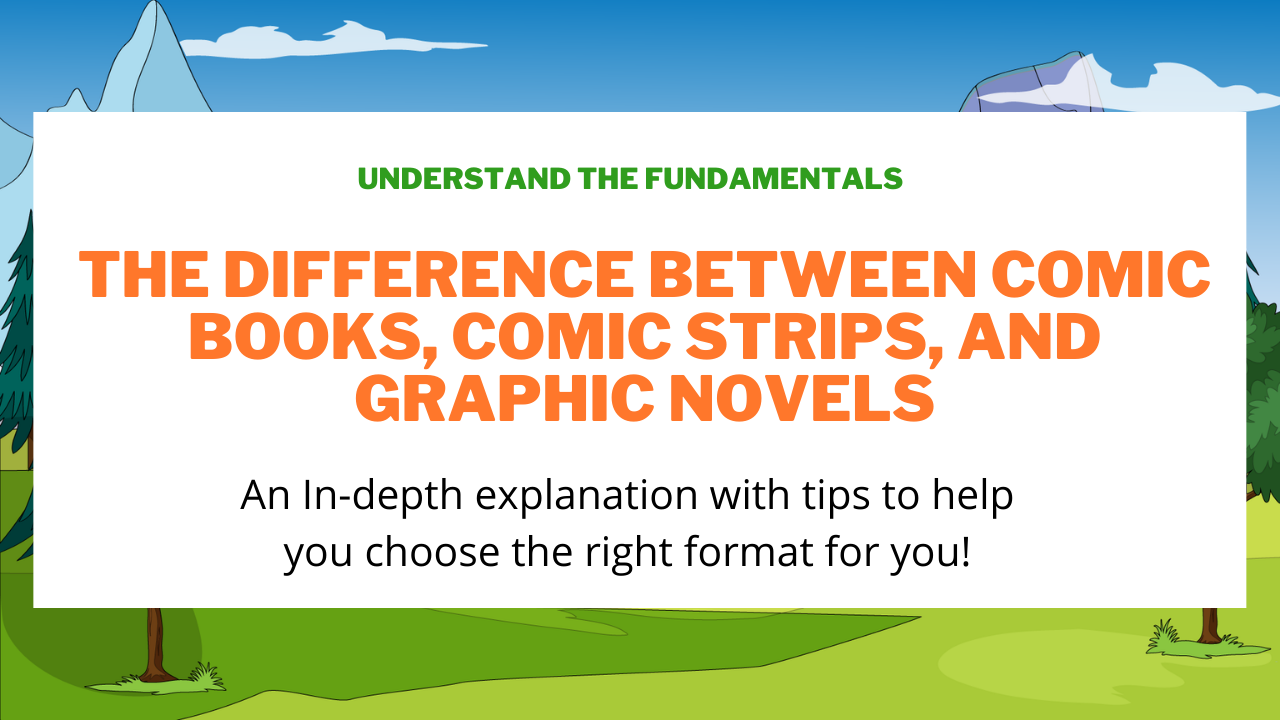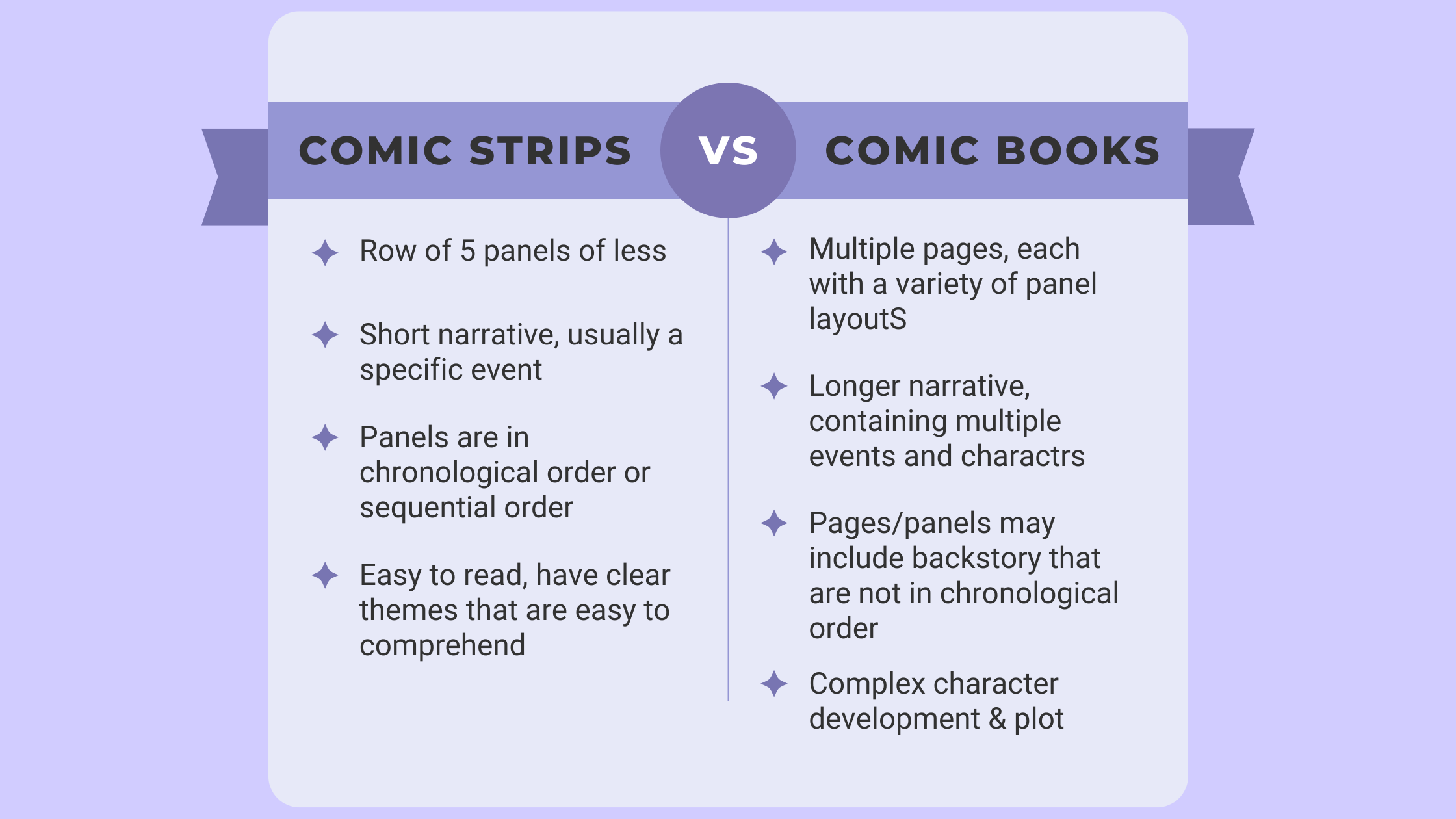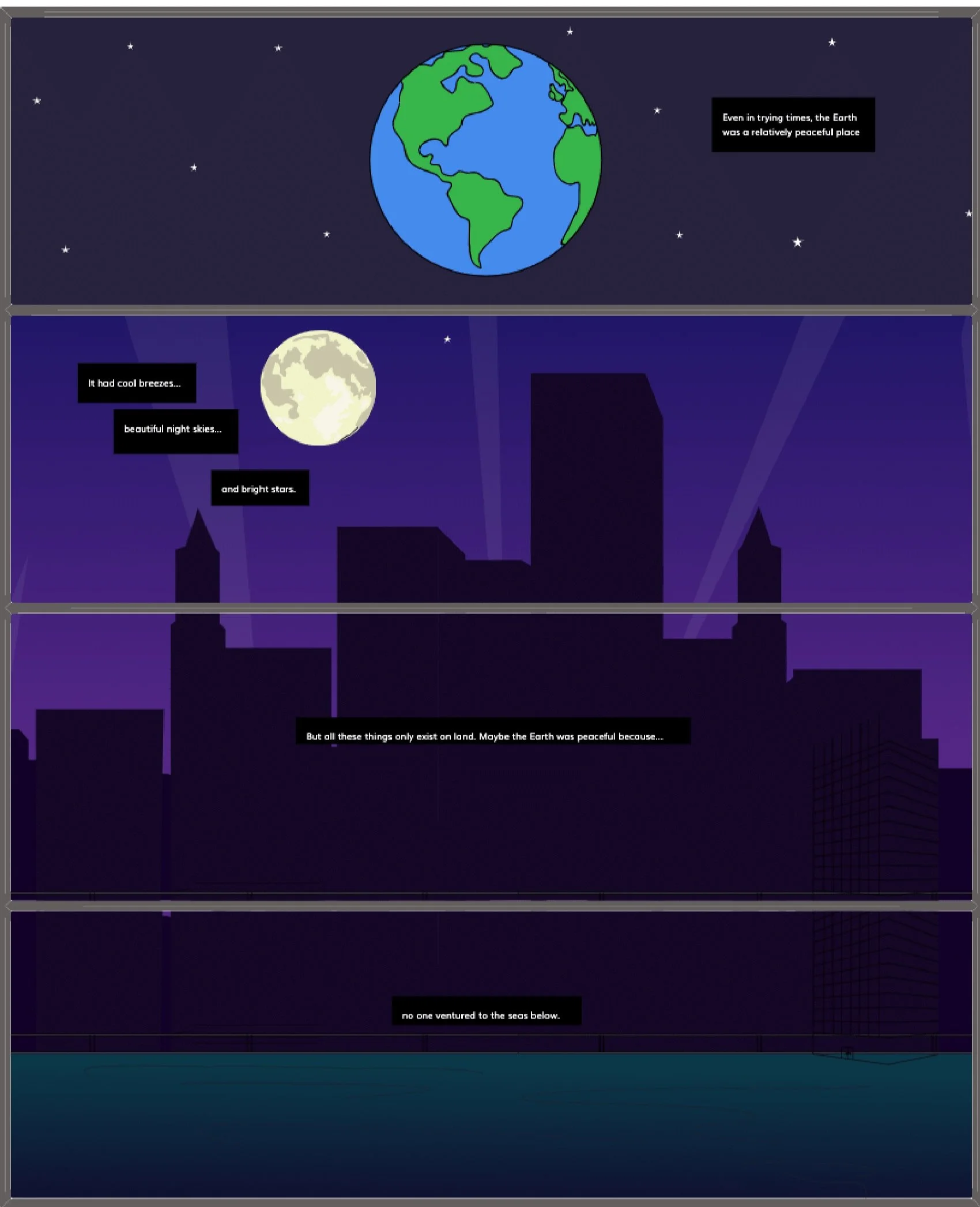The Difference Between Comic Books, Graphic Novels, & Comic Strips
Comic books, comic strips, and graphic novels are not the same.
One of the most common misconceptions is that comic books, comic strips, and graphic novels are the same. Not only are they all different from one another, but they all tell stories using different formats and styles.
Using the umbrella term comics to refer to all mediums is a mistake many individuals make, and we want to help clear up this confusion by giving you a clear representation of each one.
To learn about the differences between comic books, comic strips, and graphic novels, take a look at our breakdown below.
What is a graphic novel, and how does it differ from comic books and comic strips?
The difference between graphic novels compared to comic books and comic strips is that they tell a complete narrative from start to finish in one novel. Even if they are a part of a series, each novel will have its stand-alone story allowing for a longer and more complex plot. Comic books, on the other hand, tell serialized narratives, so it may be hard to understand a comic book if you haven't read the series from the very beginning of the comic book that came right before.
Because of the complete narrative format, readers can pick up a graphic novel and understand the plot without remembering details from past stories in the series.
Popular graphic novels include Baby-Sitters Club, Smile, Diary of a Wimpy Kid
Pros of the graphic novel: Because graphic novels tell complete narratives with a guaranteed conclusion, they allow the writer to craft narratives with greater complexity with moody themes and characters that undergo great evolution/transformation. Because of its format, readers can expect major plot points, characters, and developments that reach a clear ending.
Cons of the graphic novel: Graphic novels are a complete narrative with a single volume. Because of this format, there will be less time spent developing the novel's world and characters. Because the story must start and end in one novel, the characters spend less time exploring and adventuring in their unique world and more time tackling the central conflict.
🔥 HOT TIP🔥
Use the graphic novel format for your story if:
If you envision your story having a clear and contained sequence of events, the graphic novel format is for you. However, if you see your narrative as part of a unique world with an ever-growing list of new characters, subplots, and themes, then the comic book format may be for you.
Continue reading to learn more about comic books.
What is a comic book, and how does it differ from comic strips and graphic novels?
The difference between comic books compared to comic strips and graphic novels is that comic books have serialized narratives. They typically tell stories through multiple books and throughout different volumes.
Unlike comic strips that tell a complete story in 3-4 panels, comic books use many pages to tell their story. And similarly to graphic novels, comic books typically will include subplots of various characters and adventures.
These serialized narratives will be drawn out throughout multiple volumes and connect to past stories in the series. Though you can typically pick up and read a comic book anywhere within the series, you will have a better understanding of the comic book's world, theme, plot, and characters reading them from the beginning.
Some examples of popular comic books include Superman, Batman, and X-Men.
Pros of the comic book: Because comic books tell serialized narratives, they allow the writer to develop larger plots that develop over multiple volumes, creating opportunities to introduce more subplots, create a larger ensemble of characters, and explore lengthier adventures.
Cons of the comic book: Because of the serialized narrative format, you may have difficulty understanding the characters or the chronology of events that have already taken place within the series. Additionally, the more volumes associated with comics may require more planning from the writer.
🔥 HOT TIP🔥
Should you use the comic book format for your narrative?
If you envision your story as being a part of a unique world with new characters, subplots, and themes, then the comic book format is for you. This format allows you to craft new subplots with unexplored themes, characters, and adventures throughout many volumes.
Do your story ideas need only a short sequence? Take a look at the comic strip format.
What is a comic strip, and how does it differ from comic books and graphic novels?
Comic strips differ from comic books and graphic novels by the way comic strips tell a complete narrative in a short 3-4 panel sequence. The most common well-known comic strips are those you’ll find in newspapers or the Sunday Funnies. Comic strips are arranged in sequential order with a small number of panels limited to one page, while comic books are compiled of multiple pages and tell more complex stories that can have backstories and side quests.
Popular comic strips include Calvin and Hobbs, Peanuts, and Garfield.
Pros of the comic strip: Because comic strips tell short stories, they typically do not require a complex plot. Their short sequences make them easy to read, and they have clear themes that are easy to comprehend
Cons of the comic book: The shortened storytelling format may make complex character development more difficult. Comic strips must develop the setting, introduce characters, and bring the plot full-circle in a short sequence.
🔥 HOT TIP🔥
Should you use the comic strip as your story format?
If you’re looking to tell a quick story, a comic strip is a great option. This format allows you to create multiple short stories, and you can create a variety of plots that do not require complex themes or many pages to develop. This is a great option for slice of life narratives.
Remember to include all the storytelling fundamentals in your story
Though comic books, comic strips, and graphic novels differ in format, they should all follow basic storytelling fundamentals. They should have a central theme, character, and plot development. If you need help creating a story with all the critical elements, check out our article “How to create a comic book, no drawing required!” for guidelines on constructing a great story.
Whichever medium/format you choose, consider using Storyspread.com.
Our software allows you to create any format/medium you choose, whether you want to create a comic book, comic strip, or graphic novel. Our editing tools make comic creation easy and fun, and our simple drag-and-drop feature means you don’t have to worry about drawing.
You have control over your layout and can choose from various templates, different settings, characters, and objects to bring your story to life. With our built-in text features, you can create a dialogue between characters and add captions to tell your story.
Sign up for our beta software here.
We hope this breakdown gives you a better understanding of the differences between comic books, comic strips, and graphic novels. Feel free to leave us a comment or leave your questions below.
Hi, Welcome to Storyspread.com!
Comic creation made simple. Create graphic novels with a single click. Add character, backgrounds, and more.
Easy to use. Say goodbye to searching far & wide for an expensive illustrator.
Tell your story. Join other creatives, readers, and hobbyist in producing high quality & beautiful comics
Read. Read other’s comics for FREE and share with others
Grow. Grow an audience you love with the stories YOU imagined
Were you can create a comic and graphic novel WITHOUT drawing. Simple and easy! Made for all skill levels. Click-n-drag comic book characters, scences into panels.
Create a comic just like this! Here.






